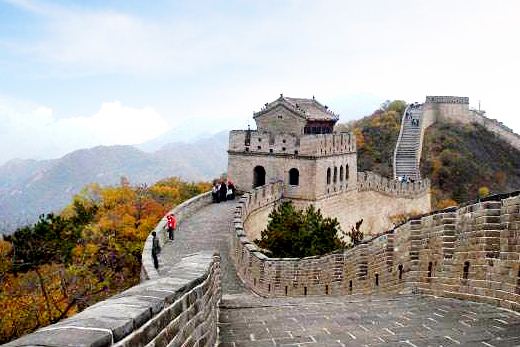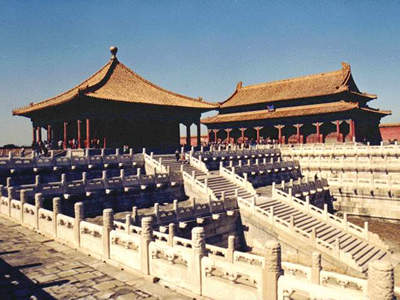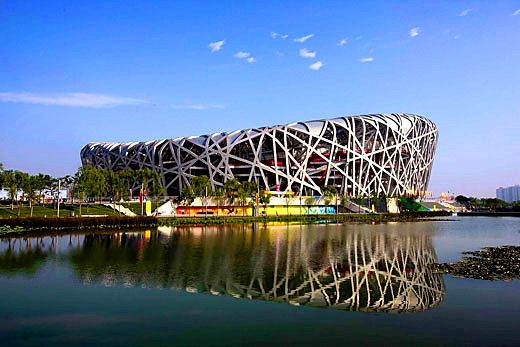Three-Hill Convent (Sanshan' an)
A short distance from the Temple of Divine Light stands the Three-Hill Convent, which derives its name from the fact that it is situated between Cuiwei Hill, Pingpo Hill and Lushi Hill. Though the convent is 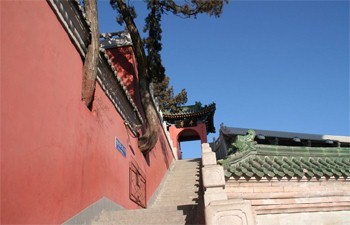 not large and consists of only one courtyard, it is of rather exquisite construction. At the doorway of the main hall there is a rectangular"Cloud and Water Stone,"carved with images of scenery, human figures and animals. To the east of the main hall is a small kiosk with an inscribed plaque which reads"Cuiwei Hill is part of a painting."Looking out from here, one can see many peaks covered with pines and cypresses. The temple is set in the midst of a dense forest that provides a cool and pleasant place for a stroll. During the dog days, a visitor will find it an excellent place to escape the heat. The Three-Hill Convent is a common starting point for mountaineering.
not large and consists of only one courtyard, it is of rather exquisite construction. At the doorway of the main hall there is a rectangular"Cloud and Water Stone,"carved with images of scenery, human figures and animals. To the east of the main hall is a small kiosk with an inscribed plaque which reads"Cuiwei Hill is part of a painting."Looking out from here, one can see many peaks covered with pines and cypresses. The temple is set in the midst of a dense forest that provides a cool and pleasant place for a stroll. During the dog days, a visitor will find it an excellent place to escape the heat. The Three-Hill Convent is a common starting point for mountaineering.
The Temple of Great Mercy (Dabeisi)
Climbing up from the Three-Hill Convent, one passes many strange rock formations before arriving at the fourth of the Eight Great Temples, the Temple of Great Mercy. The three main halls in the temple complex date from different eras of the Ming Dynasty; the most recently built being the rearmost Hall of Great Mercy. On the front hall hangs a plaque inscribed with the words "Sea of Mercy,"and the courtyard before it is densely planted with a rare species of bamboo which remains green throughout the winter. The courtyards also contain potted landscapes, fragrant plants and decorative rockeries. Also of interest to sightseers are the two huge gingko trees in the rear courtyard, reputed to be more than 800 years old.
The carved statues of the 18 arhats in the front hall of the temple are some of the finest in all of the Eight Great Temples. Legend has it that the famous Yuan Dynasty sculptor made them Liu Yuan.
The Temple of Dragon King (Longwangtang)
The Temple of Dragon King, located to the northwest of the Temple of Great Mercy, is also known as Dragon Spring Convent. It was built in early Qing Dynasty.
Entering the temple, one first notices the sound of a bubbling spring breaking 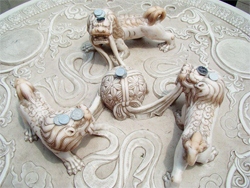 the stillness. The spring bubbles up from beneath a cliff behind the second courtyard and flows through the first courtyard and out of a carved stone spigot in the shape of a dragon's head into a pond. The water of this eternally flowing spring is clear and sweet and never freezes in winter. The Pavilion for Listening to the spring stands nearby.
the stillness. The spring bubbles up from beneath a cliff behind the second courtyard and flows through the first courtyard and out of a carved stone spigot in the shape of a dragon's head into a pond. The water of this eternally flowing spring is clear and sweet and never freezes in winter. The Pavilion for Listening to the spring stands nearby.
Behind the pond is the Hall of the Dragon King, which according to a local legend, is the residence of the Dragon King. The hall is surrounded by luxuriant green bamboo.
The Pavilion of Reclining Leisure and the Pavilion for Listening to the spring, both of which are built against the mountain, are fine spots for viewing the distant hills.
At several places in the temple, inscriptions in the calligraphy of Emperor Qianlong, can be seen.
The Temple of Fragrant World (Xiangjiesi)
Also known as the Pingpo Temple, the Temple of the Fragrant World is the largest temple complex in the entire area. In the past, it served as the summer villa of Chinese emperors. Even today the Imperial Palace and Scripture Repository erected by Emperor Qianlong can still be seen. The temple also contains numerous historical relics as well as paintings and calligraphy by known artists.
Several hundred stone steps lead the visitor to the Mahayana Gate and the entrance tot eh temple. Inside, the courtyard is full of fine flowers and trees. Near the eastern corner there is a large magnolia tree as tall as the building. It is said that this tree was planted in the Ming Dynasty, and is the only specimen of its kind in all the Eight Great Temples.
The central structure in the temple is the Scripture Repository, with drum and bell towers to the left and right of it, and the Imperial Palace to the east. Inside the Scripture Repository are statues of Kasyapa, Sakyamuni and Maitreya, the Past, Present and future Buddhas, which are flanked on both sides by polychrome statues of the 18 arhats. In the entrance hall of the Imperial Palace there is the Study for Distant Viewing, offering a fine view of the hills, plains and trees of the area west of the capital.
The Pingpo Temple, named after the hill on which it was built, has a history traceable back to the Tang Dynasty. In the 15th century, when a Ming princess named Cuiwei was buried here, the hill was named after her. The temple was rebuilt and renamed three times, its present name being bequeathed in 1748 by Emperor Qianlong. The extant buildings all date from the Ming and Qing dynasties.
The Cave of Precious Pearls (Baozhudong)
On the steep path that leads up the hill from the Temple of the Fragrant World, there stands a memorial archway with the inscription,"Place of Happiness"on one side and"Forest of Solidity" on the other. There is also a large grotesque rock inscribed with poems in the calligraphy of various emperors. The hall erected behind this archway is the famous Temple of Precious Pearls. This is the highest point in all the Eight Great Temples, and thus the open gazebo in front of the temple is named the Pavilion for Distant Viewing. On clear days one can see the entire city of Beijing, with Kunming Lake to the east, the Yongding River to the south and the city skyline in the center. Immediately below are the other seven temples and the Asian Students' Sanatorium.
The temple's name comes from the cavern behind the main hall and s stone near its entrance, which resembles a large pearl. Though the floor area of the cave is no more than 25 square meters, a Qing monk named Hai Xiu lived there for 40 years. A status of this Long-term resident standing inside the cavern is popularly known as the"King-of-the-Ghost-Bodhisattva."
The Mysterious Devil's Cliff (Mimoyan)
Heading north down the hill from the Cave of Precious Pearls and climbing up Lushi Hill, one passes through a dense grove of trees before coming to an old temple known as the Temple of Buddha hood or the Temple of Pacifying the Nation. Inside the temple courtyard there are exquisitely wrought rockery hills. Directly in front of the main hall is a stone tablet testifying to the Buddha's mercy, and behind it a two-meter-high bronze bell, both dating from the Ming Dynasty.
Following the winding path from the western gate of the temple past another pavilion, one comes to the last of the Eight Great Temples, the Mysterious Devil's Cliff. The main feature of the cliff is a large over-hanging rock which, when seen from afar, suggests the image of a roaring lion. On the stone are carved the words,"Natural Secluded valley"and a number of inscriptions by visitors cliff is reputed to have been the home of the monk Lu Shi, who in the seventh century traveled from southern China to the outskirts of the capital in a rowboat. The legend has it that a pair of dragons he had accepted by ending a terrible drought, whereupon the hill was dubbed Lushi Hill Cave. Down through the ages, the two dragon-disciples have been the subject of numerous folktales and the object of respect and worship for their good deeds.
The Temple of Buddha hood, one of the older and large temples in the area, was first built in the Sui and Tang period more than 1,200 years ago. The name was changed several times during the ages, yet each of these changes reflected the temple's close association with Lu Shi and his auspicious dragons. The present name of the temple was fixed in 1460 during the Ming Dynasty, and many of the buildings that remain show evidence of Ming architectural style.


 About Beijing
About Beijing 
